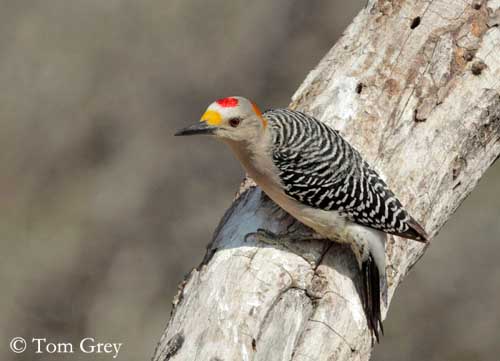
PROTECTION / THREATS / STATUS:
The populations appear stable. They have increased in the second half of 20th century, with proliferation of mesquite for nesting. This species has also successfully colonized the urban parks.
The Golden-fronted Woodpecker is common to fairly common throughout its range, even locally very common.
The species is not currently threatened.
Fr: Pic à front doré
All : Goldstirnspecht
Esp : Carpintero Frentidorado
Ital : Picchio frontedorata
Nd : Goudvoorhoofdspecht
Sd : Gulpannad hackspett
Photographer :
Tom Grey
Tom Grey's Bird Pictures
Text by Nicole Bouglouan
Sources :
HANDBOOK OF THE BIRDS OF THE WORLD Vol. 7 by Josep del Hoyo-Andrew Elliott-Jordi Sargatal – Lynx Edicions – ISBN: 8487334377
FIELD GUIDE TO THE BIRDS OF NORTH AMERICA - National Geographic Society - ISBN: 0792274512
All About Birds (Cornell Lab of Ornithology)
The Birds of North America online
What Bird-The ultimate Bird Guide (Mitchell Waite)
Golden-fronted Woodpecker
Melanerpes aurifrons
Piciforme Order – Picidae Family
BIOMETRICS:
Length: 22-26 cm
Wingspan: 43 cm
Weight: 65-100 g
DESCRIPTION:
The Golden-fronted Woodpecker is a nice bird living in arid or semi-arid areas.
It as barred black and white back and upperwings, and the rump is white. The tail is usually black, but sometimes we can see some white barring on the outer rectrices in fresh plumage. A white wing patch is visible in flight, as a white crescent, formed by the white bases of the outer primaries.
The underparts are pale greyish, with yellow centre of belly. The lower flanks and the undertail-coverts are barred blackish, but this pattern is more indistinct on the flanks.
The male has red patch on head top, and golden orange nape. The forehead is golden-yellow, giving the bird its name.
The bill is black. The eyes are reddish brown. Legs and feet are pale grey.
The female has pale greyish head, without red. The forehead shows a small pale yellow patch, as the hindneck. She is duller than male overall.
Juvenile has streaked breast and brownish cap. It is duller than adults with less contrasting markings. Eyes are brown.
We can find several subspecies. They differ in head and tail pattern, barring and darkness of the underparts.

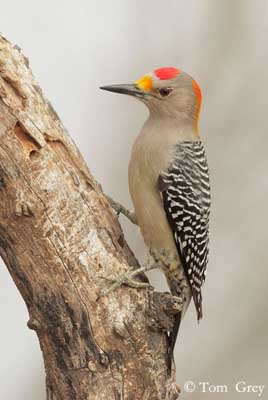
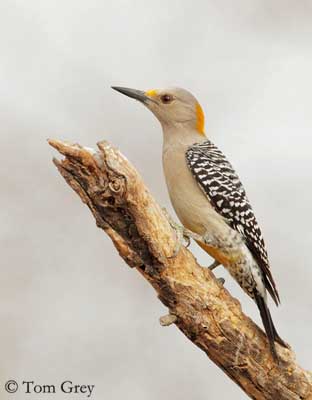
VOICE: SOUNDS BY XENO-CANTO
The call of the Golden-fronted Woodpecker is a rolling “churr-churr” given singly or in series, and a loud, raspy cackling “kek-kek”.
We can also hear a rapid nasal “yuk-yuk-yuk-yuk”, and drums.
HABITAT:
The Golden-fronted Woodpecker frequents scrublands at desert’s edges, vegetation with mesquite (Proposis), cottonwood groves, and bushy areas along small streams, open areas on floodplains, wooded canyons, rural country, suburban areas and parks.
In Central America, it frequents arid tropical scrub with paloverde (Cercidium praecox), mesquite and cacti.
It can be seen from sea-level up to 2500 metres of elevation.
RANGE:
The Golden-fronted Woodpecker is resident from south-western Oklahoma, and southwards, through Central Texas and eastern Mexico to Nicaragua.
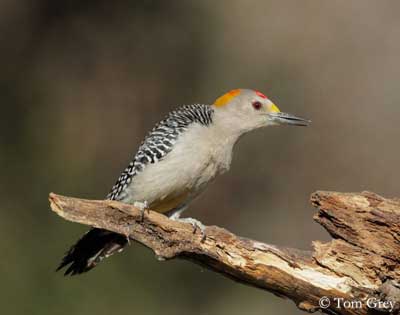
BEHAVIOUR:
The Golden-fronted Woodpecker gleans insects into the bark crevices, probes into holes and scales the bark. It also hawks flying insects. It often gleans on the ground with other species. It climbs along tree-trunks to search food. It hunts alone or in pairs, but also in family groups.
This woodpecker may sometimes store food such as seeds, nuts or fruits, in holes and crevices at the beginning of the winter, and defends this area against other birds’ species.
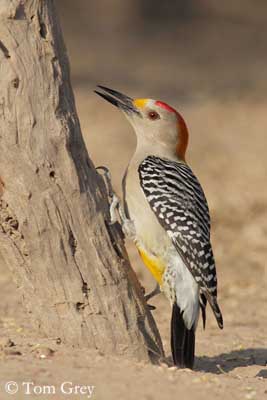
Often perched on poles and trees along the roadsides, it is common, conspicuous and noisy.
This bird has specialized skull and beak, heavily ossified to support the vigorous impacts. It also has an adapted tongue, and the bird is able to thrush it out several centimetres past their bill.
Drumming serves to establish the territory and to attract females.
FLIGHT:
The Golden-fronted Woodpecker flies with peculiar undulating flight.
REPRODUCTION:
The breeding season varies according to the range.
The Golden-fronted Woodpecker often uses the same cavity each year, often in pecan tree, oak or mesquite, and occasionally in nest-boxes.
Both male and female excavate a nice round hole into a trunk or a large branch of dead or live tree, between 2 and 9 metres above the ground. The cavity is lined with some wood chips.
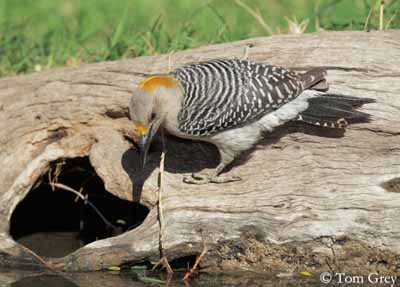
The female lays 4 to 5 shiny, round and white eggs. The incubation lasts about 12 to 14 days, shared by both parents, the male mainly at night. The chicks are altricial. They are brooded and fed by both adults. They fledge 30 days after hatching. They follow their parents for several weeks, sometimes until the autumn.
This species usually produces two clutches per season.
DIET:
The Golden-fronted Woodpecker feeds on wide variety of insects and their larvae such as wood-boring insects, grasshoppers, beetles and ants, and also spiders. It also eats vegetal matter, such as corn, acorn, nuts, various seeds, wild fruits and berries. It could take bird eggs.
It gleans on branches and trunks by probing into the bark crevices and the holes in the wood, and can be seen also on the ground.